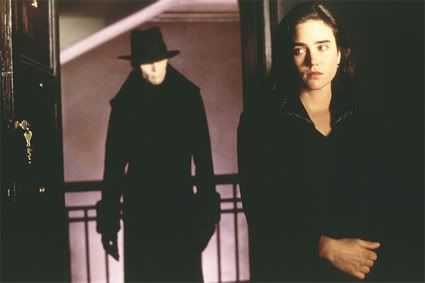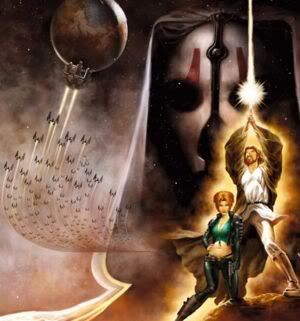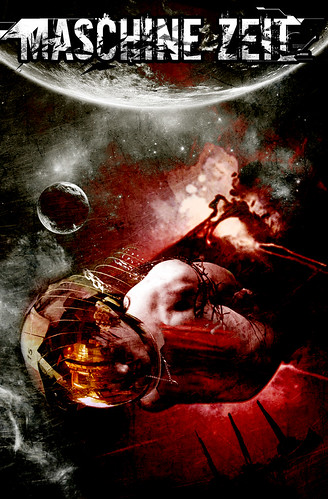
[audio:http://www.blueinkalchemy.com/uploads/pandorum.mp3]
I am loathe to admit this, but I’ve made it a point in my writing and especially this series not to be disingenuous in my assertions. That’s a good way to get punched in the face. So here it is: I don’t like spook houses. Those standalone buildings in carnivals, fairs and amusement parts where part-timers are paid to jump out of closets at you? Yeah. Not really my scene. I don’t consider it horrific when I get startled. It’s just annoying. Around this time last year when Pandorum was out I didn’t really pay much attention to it, half-expecting it to be a jump-out scarefest dressed up as a high-concept sci-fi horror flick. This is one of those times when I’m pretty happy to admit I was wrong.
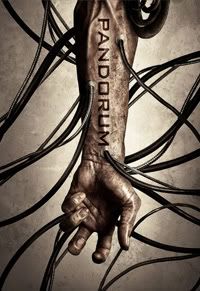
The Elysium is a spacecraft carrying thousands of colonists and biological samples for the settlement of the distant Earth-like planet of Tanis. Earth has just about run out of room and resources. While humanity suffocates on its own wastefulness and hubris, the Elysium‘s passengers are kept in deep cryogenic sleep for their 123-year journey with the promise that they’ll save anybody left behind. When Corporal Bowers wakes up for his shift, however, there are immediate problems. He’s been out long enough to lose parts of his memory. His ship is dying, its reactor core malfunctioning and its navigational systems unable to tell him where they are. His superior officer, Lieutenant Payton, has a similar memory problem when he wakes up. As Bower heads for the reactor to fix the ship and Peyton acts as mission control at the one working console, two things become apparent very quickly: The officers are not alone aboard the Elysium, and one or both of them are suffering from a mental condition similar to nitrogen narcosis related to extended cryogenic sleep – a condition they call Pandorum.
Do you have a feeling you know where this is going? If not, maybe you should consider watching more movies. Specifically, you need to check out Alien, The Descent and Event Horizon, because those are movies that at best inspired Pandorum and at worst were victims of a blatant idea mugging at its hands. Players of System Shock 2 or Dead Space will feel right at home as well. On the surface, there isn’t much about the concept, narrative through-line or inevitable “twist” moments that haven’t been seen, experienced or lampshaded before. But that’s a general overview and maybe a little unfair. The devil, as they say, is in the details.

It’s a shame more PhDs aren’t this badass. Or this hot.
It’s been said that as soon as you fill your spaceship with metal grating floors devoid of carpeting and lights that flicker on and off, your protagonists might as well use marinade for a shampoo. However, in the case of Pandorum, the set design is a big part of the atmosphere. This ship is old, with limited power and even more limited resources. Instead of dropping beefy space marines or even powered armor the protagonists have to learn to use into the situation, our heroes have little more than their clothes on their backs and whatever improvised weapons they can lay their hands on. I never said borrowing from Alien was a bad thing, after all. We’re pulled into the story and feeling the dread and claustrophobia of Bower long before we see our first creature.
Speaking of which, this was the second work of Stan Winston’s legendary creature shop after the mastermind’s untimely passing. The first was G.I. Joe – the less said about that the better. Anyway, I might have appreciated the psuedo-tribal designs and creepiness more if I’d gotten better looks at these things, however the camera moves so damn much whenever they’re around that it’s really difficult to do so. Giving fleeting glimpses of a monster instead of showing us what we’re in for is good as a rule. It’s why the original Predator works on a level that neither Aliens vs. Predator movie comes close to reaching. But the more Pandorum goes on, the more it feels the film crew shot it this way after getting drunk and deciding emulating Michael Bay’s camera work was a great idea for their fight scenes.
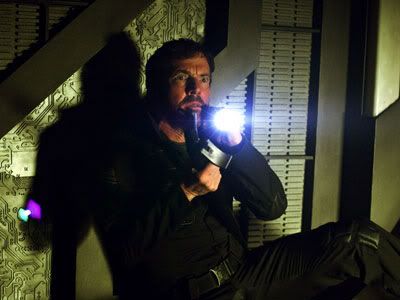
I don’t think Dennis wants to be reminded of G.I. Joe, either.
Another problem this movie has is in sound design. Now, the soundtrack of Pandorum isn’t all that bad, at least to my ears but then again I’m a sucker for tribal drums in my sci-fi, e.g. Bear McCreary’s kickass music for Battlestar Galactica. And the screams of the creatures are fine, creaking bulkheads, visceral tearing noises, etc. The problem I had was with the level of dialog. With so much else going on it’s really easy to lose lines or entire exchanges as they’re frantically whispered between the survivors. I understood that being quiet was necessary for survival in most of the open areas of the ship, but some scenes were very difficult for me to follow in terms of dialog. Then again, this might be the fault of watching this via the Netflix Instant service in a room right next to a busy intersection.
There are a lot of minor flaws in the overall movie that would cripple the entire project if there weren’t good things holding them up. Beyond the set design and lighting, we have a pace that gradually builds the tension and is in no rush to get to the bottom of the mysteries, opting instead to keep the action moving and build the characters. Par for the course considering this somewhat derivative material, the characters we get aren’t really all that deep or unique. However, what I like about them is that none of them are beefy macho space marines. The obligatory knife-twirling action babe began life as a geneticist and her stoic, large spear-wielding guardian was a farmer. These are normal people that managed to survive in extraordinary circumstances. The closest we come to military characters are Payton and Bower. And while Bower does some of the heavy lifting action-wise, he’s not exactly the Emperor’s Finest.

Bower and the film’s only ray gun.
This is a good thing, though. It’s one of the best things Pandorum has going for it. Ben Foster as Bower does just about everything right in ways that invoke pleasant memories of Bruce Willis playing John McClaine in Die Hard. He and the other survivors demonstrate good instincts and decent cognitive skills, for the most part. There’s only one point at which an audience might yell at the screen at a character for making a bad decision. I’ve always liked Ben Foster, from his funny and touching turn as Spacker Dave in The Punisher to his unhinged second gun to Russell Crowe in 3:10 To Yuma. Seeing him take the lead here is a very pleasant experience, and as much as Bower might be just an engineer and not cut out for combat or extreme survival, there is a scene in which my jaw was hanging open – not at the visuals, not at the viscera, but merely at the demonstration of an everyday guy having some big, brass balls.
It’s nowhere near a perfect movie. In terms of sci-fi horror, Alien has nothing to worry about. Pandorum is saved from failure by surprisingly decent writing and acting, excellent set design and a premise that assumes the audience is smart enough to follow along without needing things explicitly spelled out every step of the way. They just seem to forget that we’ve seen other movies before, meaning we’ve seen some of these elements before as well. If Pandorum were a baked concoction, you’d throw together equal parts Alien, The Descent and Titan AE, dash it with a little Dead Space and frost it with Event Horizon after it’s done baking. The result probably isn’t all that good for you and you’ll have tasted better, but that doesn’t stop this particular little experiment from tasting pretty damn good.
Josh Loomis can’t always make it to the local megaplex, and thus must turn to alternative forms of cinematic entertainment. There might not be overpriced soda pop & over-buttered popcorn, and it’s unclear if this week’s film came in the mail or was delivered via the dark & mysterious tubes of the Internet. Only one thing is certain… IT CAME FROM NETFLIX.

